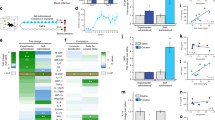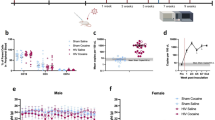Abstract
Cocaine use disorder is associated with alterations in immune function including altered expression of multiple peripheral cytokines in humans—several of which correlate with drug use. Individuals suffering from cocaine use disorder show altered immune system responses to drug-associated cues, highlighting the interaction between the brain and immune system as a critical factor in the development and expression of cocaine use disorder. We have previously demonstrated in animal models that cocaine use upregulates the expression of granulocyte colony-stimulating factor (G-CSF)—a pleiotropic cytokine—in the serum and the nucleus accumbens (NAc). G-CSF signaling has been causally linked to behavioral responses to cocaine across multiple behavioral domains. The goal of this study was to define whether increases in G-CSF alter the pharmacodynamic effects of cocaine on the dopamine system and whether this occurs via direct mechanisms within local NAc microcircuits. We find that systemic G-CSF injection increases cocaine effects on dopamine terminals. The enhanced dopamine levels in the presence of cocaine occur through a release-based mechanism, rather than through effects on the dopamine transporter—as uptake rates were unchanged following G-CSF treatment. Critically, this effect could be recapitulated by acute bath application of G-CSF to dopamine terminals, an effect that was occluded by prior G-CSF treatment, suggesting a similar mechanistic basis for direct and systemic exposures. This work highlights the critical interaction between the immune system and psychostimulant effects that can alter drug responses and may play a role in vulnerability to cocaine use disorder.




Similar content being viewed by others
References
Beattie EC et al (2002) Control of synaptic strength by glial TNFalpha. Science 295:2282–2285
Becker JB, Chartoff E (2019) Sex differences in neural mechanisms mediating reward and addiction. Neuropsychopharmacology 44:166–183
Brady LJ, Hofford RS, Tat J, Calipari ES, Kiraly DD (2019) Granulocyte-colony stimulating factor alters the pharmacodynamic properties of cocaine in female mice. ACS Chem Neurosci 10:4213–4220
Calipari ES et al (2017) Dopaminergic dynamics underlying sex-specific cocaine reward. Nat Commun 8:13877
Calipari ES et al (2018) Granulocyte-colony stimulating factor controls neural and behavioral plasticity in response to cocaine. Nat Commun 9:9
Cao X-Q et al (2006) Recombinant human granulocyte colony-stimulating factor protects against MPTP-induced dopaminergic cell death in mice by altering Bcl-2/Bax expression levels. J Neurochem. https://doi.org/10.1111/j.1471-4159.2006.04125.x
Chen R et al (2006) Abolished cocaine reward in mice with a cocaine-insensitive dopamine transporter. PNAS 103:9333–9338
Clarke DJ, Branton RL (2002) A role for tumor necrosis factor α in death of dopaminergic neurons following neural transplantation. Exp Neurol 176:154–162
Dantzer R (2018) Neuroimmune interactions: from the brain to the immune system and vice versa. Physiol Rev 98:477–504
Datta U et al (2020) Prospects for finding the mechanisms of sex differences in addiction with human and model organism genetic analysis. Genes Brain Behav 19:645
Di Chiara G (1999) Drug addiction as dopamine-dependent associative learning disorder. Eur J Pharmacol 375:13–30
Felger JC (2017) The role of dopamine in inflammation-associated depression: mechanisms and therapeutic implications. Curr Top Behav Neurosci 31:199–219
Felger JC, Miller AH (2012) Cytokine effects on the basal ganglia and dopamine function: the subcortical source of inflammatory malaise. Front Neuroendocrinol 33:315–327
Felger JC et al (2013) Chronic interferon-α decreases dopamine 2 receptor binding and striatal dopamine release in association with anhedonia-like behavior in nonhuman primates. Neuropsychopharmacology 38:2179–2187
Fox HC et al (2012) Immune system inflammation in cocaine dependent individuals: implications for medications development. Hum Psychopharmacol 27:156–166
Franken IHA, Booij J, van den Brink W (2005) The role of dopamine in human addiction: From reward to motivated attention. Eur J Pharmacol 526:199–206
Galván ST et al (2021) Plasma concentrations of granulocyte colony-stimulating factor (G-CSF) in patients with substance use disorders and comorbid major depressive disorder. Sci Rep 11:13629
Hodes GE, Kana V, Menard C, Merad M, Russo SJ (2015) Neuroimmune mechanisms of depression. Nat Neurosci 18:1386–1393
Hodes GE, Ménard C, Russo SJ (2016) Integrating interleukin-6 into depression diagnosis and treatment. Neurobiology of Stress 4:15–22
Hofford RS, Russo SJ, Kiraly DD (2019) Neuroimmune mechanisms of psychostimulant and opioid use disorders. Eur J Neurosci 50:2562–2573
Hofford RS et al (2021) Granulocyte-colony stimulating factor reduces cocaine-seeking and downregulates glutamatergic synaptic proteins in medial prefrontal cortex. J Neurosci 41:1553–1565
Huang H-Y, Lin S-Z, Kuo J-S, Chen W-F, Wang M-J (2007) G-CSF protects dopaminergic neurons from 6-OHDA-induced toxicity via the ERK pathway. Neurobiol Aging 28:1258–1269
Jones SR, Gainetdinov RR, Wightman RM, Caron MG (1998) Mechanisms of amphetamine action revealed in mice lacking the dopamine transporter. J Neurosci 18:1979–1986
Jones SR et al (1998) Profound neuronal plasticity in response to inactivation of the dopamine transporter. Proc Natl Acad Sci USA 95:4029–4034
Kumar AS et al (2016) Molecular mechanism of regulation of MTA1 expression by granulocyte colony-stimulating factor. J Biol Chem 291:12310–12321
Kutlu MG et al (2018) Granulocyte colony stimulating factor enhances reward learning through potentiation of mesolimbic dopamine system function. J Neurosci 38:8845–8859
Lacagnina MJ, Rivera PD, Bilbo SD (2017) Glial and neuroimmune mechanisms as critical modulators of drug use and abuse. Neuropsychopharmacology 42:156–177
Lewitus GM, Pribiag H, Duseja R, St-Hilaire M, Stellwagen D (2014) An adaptive role of TNFα in the regulation of striatal synapses. J Neurosci 34:6146–6155
Lewitus GM et al (2016) Microglial TNF-α suppresses cocaine-induced plasticity and behavioral sensitization. Neuron 90:483–491
López AJ et al (2021) Cocaine self-administration induces sex-dependent protein expression in the nucleus accumbens. Commun Biol 4:1–13
Lucerne KE, Osman A, Meckel KR, Kiraly DD (2021) Contributions of neuroimmune and gut-brain signaling to vulnerability of developing substance use disorders. Neuropharmacology 192:108598
Meltzer A, Van de Water J (2017) The role of the immune system in autism spectrum disorder. Neuropsychopharmacology 42:284–298
Mervosh NL, et al. (2018) Granulocyte-colony-stimulating factor alters the proteomic landscape of the ventral tegmental area. Proteomes 6
Meuer K et al (2006) Granulocyte-colony stimulating factor is neuroprotective in a model of Parkinson’s disease. J Neurochem 97:675–686
Miller AH, Raison CL (2016) The role of inflammation in depression: from evolutionary imperative to modern treatment target. Nat Rev Immunol 16:22–34
Miller AH, Haroon E, Raison CL, Felger JC (2013) Cytokine targets in the brain: impact on neurotransmitters and neurocircuits. Depress Anxiety 30:297–306
Nolan SO et al (2020) Direct dopamine terminal regulation by local striatal microcircuitry. J Neurochem 155:475–493
Nutt DJ, Lingford-Hughes A, Erritzoe D, Stokes PRA (2015) The dopamine theory of addiction: 40 years of highs and lows. Nat Rev Neurosci 16:305–312
Pascoli V, Terrier J, Hiver A, Lüscher C (2015) Sufficiency of mesolimbic dopamine neuron stimulation for the progression to addiction. Neuron 88:1054–1066
Rothaug M, Becker-Pauly C, Rose-John S (2016) The role of interleukin-6 signaling in nervous tissue. Biochimica et Biophysica Acta (BBA) - Molecular Cell Research 1863, 1218–1227
Shuto H, Kataoka Y, Horikawa T, Fujihara N, Oishi R (1997) Repeated interferon-alpha administration inhibits dopaminergic neural activity in the mouse brain. Brain Res 747:348–351
Siciliano CA, Jones SR (2017) Cocaine potency at the dopamine transporter tracks discrete motivational states during cocaine self-administration. Neuropsychopharmacology 42:1893–1904
Stellwagen D, Malenka RC (2006) Synaptic scaling mediated by glial TNF-alpha. Nature 440:1054–1059
Tsai S-T et al (2017) Neuroprotection of granulocyte colony-stimulating factor for early stage Parkinson’s disease. Cell Transplant 26:409–416
van Heesch F et al (2013) Systemic tumor necrosis factor-alpha decreases brain stimulation reward and increases metabolites of serotonin and dopamine in the nucleus accumbens of mice. Behav Brain Res 253:191–195
Venton BJ et al (2006) Cocaine increases dopamine release by mobilization of a synapsin-dependent reserve pool. J Neurosci 26:3206–3209
Wightman RM, Zimmerman JB (1990) Control of dopamine extracellular concentration in rat striatum by impulse flow and uptake. Brain Res Brain Res Rev 15:135–144
Wightman RM et al (1988) Real-time characterization of dopamine overflow and uptake in the rat striatum. Neuroscience 25:513–523
Wohleb ES, Franklin T, Iwata M, Duman RS (2016) Integrating neuroimmune systems in the neurobiology of depression. Nat Rev Neurosci 17:497–511
Wu Q, Reith ME, Kuhar MJ, Carroll FI, Garris PA (2001) Preferential increases in nucleus accumbens dopamine after systemic cocaine administration are caused by unique characteristics of dopamine neurotransmission. J Neurosci 21:6338–6347
Yorgason JT, España RA, Jones SR (2011) Demon voltammetry and analysis software: analysis of cocaine-induced alterations in dopamine signaling using multiple kinetic measures. J Neurosci Methods 202:158–164
Acknowledgements
Cocaine hydrochloride was provided by the NIDA Drug Supply Program. Diagrams in all figures were created with Biorender.com with full permission to publish.
Funding
This work was supported by NIDA grants DA-052641 to L.J.B.; DA-044308, DA-049568, and DA-051551 to D.D.K.; and DA-042111 and DA-048931 to E.S.C. as well as by the Brain and Behavior Research Foundation (National Alliance for Research on Schizophrenia and Depression Young Investigator Awards) to E.S.C. and D.D.K., funds from the Seaver Family Foundation to A.O. and D.D.K., the Whitehall Foundation to E.S.C., and the Edward Mallinckrodt Jr. Foundation to E.S.C.
Author information
Authors and Affiliations
Contributions
L.J.B. and K.R.E. collected data, analyzed data, made figures, and wrote the manuscript. K.E.L. and A.O. analyzed the data, made figures, and wrote the manuscript. E.S.C. and D.D.K. conceptualized the manuscript, analyzed data, made figures, and wrote the manuscript.
Corresponding authors
Ethics declarations
Competing interests
The authors declare no competing interests.
Additional information
Publisher's note
Springer Nature remains neutral with regard to jurisdictional claims in published maps and institutional affiliations.
Rights and permissions
About this article
Cite this article
Brady, L.J., Erickson, K.R., Lucerne, K.E. et al. Granulocyte colony-stimulating factor (G-CSF) enhances cocaine effects in the nucleus accumbens via a dopamine release–based mechanism. Psychopharmacology 238, 3499–3509 (2021). https://doi.org/10.1007/s00213-021-05967-9
Received:
Accepted:
Published:
Issue Date:
DOI: https://doi.org/10.1007/s00213-021-05967-9




